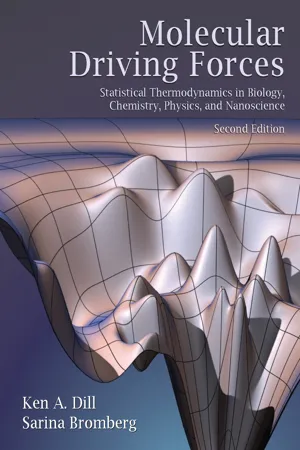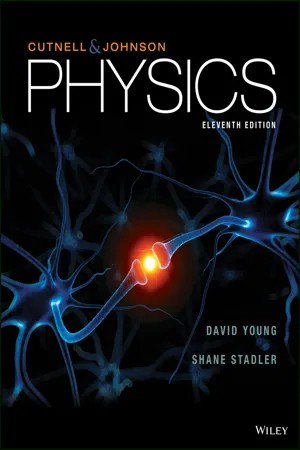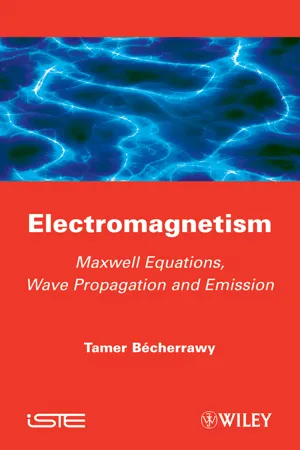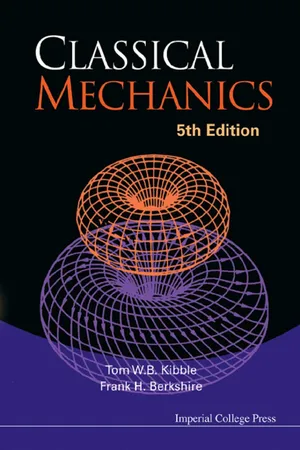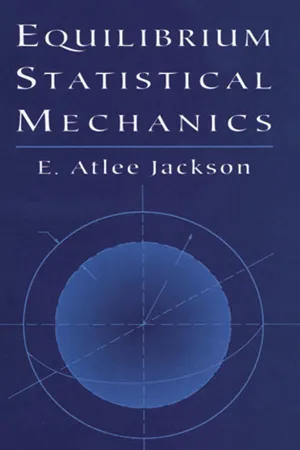Physics
Potentials
Potentials in physics refer to scalar or vector fields that represent the potential energy associated with a force or the electric potential in an electric field. Scalar potentials are used to describe conservative forces, while vector potentials are used to describe non-conservative forces. In both cases, potentials provide a way to analyze and understand the behavior of physical systems.
Written by Perlego with AI-assistance
Related key terms
Related key terms
1 of 4
Related key terms
1 of 3
8 Key excerpts on "Potentials"
- eBook - ePub
- A. L. Stanford, J. M. Tanner(Authors)
- 2014(Publication Date)
- Academic Press(Publisher)
13Electric Potential
Publisher Summary
This chapter discusses electric potential. Electric fields are vector fields that have both magnitude and direction at every point at which the field is defined. The electrical properties of space can also be described by electric potential, which is, in some respects, a simpler and more practical concept than the electric field. Electric potential is simpler than electric fields because electric potential is a scalar quantity and, therefore, has no direction associated with it. Electric potential is more practical than the electric field because differences in potential, at least on conductors, are more readily measured directly. Electric Potentials and electric fields in a given region are related to each other, and either can be used to describe the electrostatic properties of space. The gravitational potential energy of an object at a point is meaningful only in terms of the difference in potential energy between that point and the potential energy specified at some reference point. Electric potential should have characteristics similar to those of gravitational potential energy for electric potential to be equally useful.We have stressed that electric fields are a means of characterizing a physical property of space caused by the presence of electrostatic charge. Electric fields are vector fields that have both magnitude and direction at every point at which the field is defined. The electrical properties of space can also be described by electric potential, which is, in some respects, a simpler and more practical concept than the electric field. Electric potential is simpler than electric fields because electric potential is a scalar quantity and, therefore, has no direction associated with it. Electric potential is more practical than the electric field because differences in potential, at least on conductors, are more readily measured directly. - No longer available |Learn more
- Robert A. Pelcovits, Joshua Farkas(Authors)
- 2023(Publication Date)
- Barrons Educational Services(Publisher)
V (a scalar quantity) as this ratio:If we define potential as above, we can easily calculate the potential energy U of a charge of any value simply by multiplying the value of the charge by potential. For example, for charge 1, Ucharge 1 = Q1 V.Recall that the magnitude of any form of potential energy is arbitrary; only differences in potential energy have meaning. We then define voltage as the difference between the Potentials at points 1 and 2 in space:TIPVoltage is the potential difference between two points.Repeating the above derivation for very small ΔU and ΔV (such that these are differential differences), we can obtain a differential statement:Definitions of potential and voltageThe units of potential and change in the potential energy of voltage are volts, given by 1 volt = 1 joule/coulomb. One electronvolt is the amount of energy stored by a charge of e when it moves through a potential difference of 1 volt: 1 eV = (1.60 × 10− 19 C)(1 V) = 1.60 × 10− 19 J. As indicated by this equation, an electronvolt is a measure of energy, not voltage (it’s simply an alternative unit for energy that is handy when working at the atomic scale).Electrostatic Force as a Conservative Force
Recall from mechanics that not all forces have an associated potential energy function; only conservative forces do. Thus, by saying that a potential energy or potential function even exists, we are assuming that the electrostatic force is conservative. This is fairly clear from the fact that Coulomb’s law has the same mathematical form as the universal gravitational force, which we know to be conservative. The fact that we will be able to determine potential functions later in this chapter confirms this assumption. - eBook - ePub
Molecular Driving Forces
Statistical Thermodynamics in Biology, Chemistry, Physics, and Nanoscience
- Ken Dill, Sarina Bromberg(Authors)
- 2010(Publication Date)
- Garland Science(Publisher)
21 The Electrostatic Potential We Switch from Fields (Forces) to Electrostatic Potentials (Energies)The electrostatic field, introduced in Chapter 20 , describes forces, which are vector quantities. In this chapter, we switch to the electrostatic potential, which describes energies, which are scalar quantities. We switch for two reasons. First, scalars are easier to use than vectors. Second, our aim in Chapters 22 and 23 is to predict equilibria in systems in which charges play a role. To predict equilibria, we need energies.We also develop here Poisson’s equation. Poisson’s equation simplifies electrostatics calculations in many problems. We will use it in Chapter 22 to compute the energy for moving a charged particle, such as a salt ion or protein, in the vicinity of other charged objects such as proteins, colloids, DNA, polyelectrolytes, membranes, electrodes, or dielectric boundaries.What Is the Electrostatic Potential?The work dw that you must perform to move a charge q through a small distance dℓ in the presence of a fixed electrostatic field E is the negative of the dot product of the force f = qE and the displacement dℓ (see Equation (3.8) ):δ w = − f ⋅ d ℓ = − q E ⋅ d ℓ .(21.1) There is a minus sign in Equation (21.1) because this work is performed against the field, not by the field as in Equation (3.8) . To move a charge from point A to B, the total work wAB is given by the path integral (see Appendix G ),w= − qA Bℓ .∫ A BE ⋅ d(21.2) By equating wAB with the electrostatic energy, we are assuming, according to the First Law of Thermodynamics, processes that involve no heat exchange. In such cases, wAB is the maximum possible work and is called the reversible work - eBook - ePub
- John D. Cutnell, Kenneth W. Johnson, David Young, Shane Stadler(Authors)
- 2018(Publication Date)
- Wiley(Publisher)
CHAPTER 19Electric Potential Energy and the Electric PotentialIn the medical diagnostic technique of electroencephalography, electrodes placed at various points on the head detect the small voltages that exist between the points. The cap worn by the young man in this photograph facilitates the placement of a number of electrodes, so that the voltages created by different regions of the brain as he plays a flipper pinball game can be measured simultaneously. The voltage between two points is another name for the difference in electric potential between the points, which is related to the concept of electric potential energy. Electric potential energy and electric potential are the central ideas in this chapter.LEARNING OBJECTIVES
After reading this module, you should be able to…- 19.1 Define electrical potential energy.
- 19.2 Solve problems involving electric potential and electric potential energy.
- 19.3 Calculate electric potential created by point charges.
- 19.4 Relate equipotential surfaces to the electric field.
- 19.5 Solve problems involving capacitors.
- 19.6 Describe biomedical applications of electric potential.
19.1 Potential Energy
In Chapter 18 we discussed the electrostatic force that two point charges exert on each other, the magnitude of which isF = k|q1 ||q2 |/r2. The form of this equation is similar to the form for the gravitational force that two particles exert on each other, which isF = Gm1 m2 /r2, according to Newton's law of universal gravitation (see Section 4.7 ). Both of these forces are conservative and, as Section 6.4 - eBook - ePub
Electromagnetism
Maxwell Equations, Wave Propagation and Emission
- Tamer Becherrawy(Author)
- 2013(Publication Date)
- Wiley-ISTE(Publisher)
12 eV are also used.The drop in potential is the work of the electric force on the positive unit charge. We may also interpret the increase of V as the work of an external agent in displacing the positive unit charge without varying its kinetic energy. This work is independent of the path because E is conservative. Particularly, if the potential is taken to be zero at infinity, as in the expressions [2.7 ], the potential V(r) is the work that is required to bring the unit charge from infinity to the point r along any path.Figure 2.1.a) Cylindrical coordinates, and b) spherical coordinates
a) Evaluation of the field from the potential and the potential from the field In the case of time-independent phenomena, the electric field is conservative and we may introduce the electrostatic potential such that2.3. The two fundamental laws of electrostatics[2.8]Considering a displacement δr = δl e along an arbitrary axis D of unit vector e, the variation of the potential is is the component of E along D . We deduce that[2.9]This relation holds even if we know V only on the line D and it may be generalized to curvilinear coordinates. We obtain in the case of cylindrical coordinates and spherical coordinates (see Figure 2.1 ):[2.10][2.11 ]The relation E = −∇V shows that, if V is constant, E = 0 and conversely, if E = 0, V is constant. The surface of equation V(r) = C , where C is a constant, is an equipotential surface (see Figure 2.2 ). As the potential has a unique value at each point r, two equipotential surfaces cannot intersect. The field E - eBook - ePub
- Tom W B Kibble, Frank H Berkshire(Authors)
- 2004(Publication Date)
- ICP(Publisher)
Chapter 6
Potential Theory
This chapter is complementary to the preceding ones. In it we shall discuss not the problem of determining the motion of a particle under known forces, but the problem of finding the forces from a knowledge of the positions of other bodies. We deal specifically with gravitational and electrostatic forces obeying the inverse square law, which are determined by the positions of other masses and charges.We return here to the convention whereby = dr/dt. We shall not use rotating frames again until Chapter 9 .6.1Gravitational and Electrostatic Potentials
The gravitational potential energy of a particle of mass m moving in the field of a fixed mass m′ at r′ is −Gmm′/|r − r′|. If we have several masses mj , located at the points r(The fact that the potential energies add follows from the additive property of forces.)j, then the potential energy is the sumSince the mass m appears only as an overall factor, we may define the gravitational potential Φ(r) to be the potential energy per unit massso thatNote that Φ is always negative. (The potential has sometimes been defined to be minus the potential energy per unit mass, and therefore positive. We prefer, however, to retain the direct correspondence between potential and potential energy, so that particles tend to move towards regions of lower potential.)The acceleration of a particle moving under gravitational forces is given bySince this acceleration is independent of the mass m, we may define the gravitational acceleration or gravitational field g(r) byThus (6.2) and (6.3) are all that is needed to calculate the acceleration induced in a particle by a given distribution of masses.The electrostatic case is very similar. We define the electrostatic potential ϕ(r - eBook - ePub
Dielectrophoresis
Theory, Methodology and Biological Applications
- Ronald R. Pethig(Author)
- 2017(Publication Date)
- Wiley(Publisher)
Figure 4.5 and these are known as equipotential contours – or equipotential surfaces if drawn in three-dimensional space.Figure 4.5(a) A 2D plot of the equiPotentials of a dipole. Along the line equidistant from both charges the potential is zero. The potential is also zero at infinite distances from both charges. (b) A 3D plot of the variation of the potential in the vicinity of a point dipole.If instead of a collection of point charges we have a continuous distribution of charge along a wire (λ C/m), or over a surface (σ C/m2 ), or within a volume (ρ C/m3 ) the charge is divided up into small elements dq and the summation sign Σ in Equation (4.18 ) becomes an integration sign av(4.19)where r is now the distance from the charge element dq to the point of evaluation of the potential V.Equations (4.18 ) and (4.19 ) can be used to find the potential due to a collection of charges or a uniform distribution of charge. However, in some cases we have the situation where these quantities are not known, but we do know or can calculate the electric field E. In this case we are able to calculate the potential difference between two locations. The force on a test charge Qo used to probe the potential is given by F = Qo E. From Equations (4.2 ) and (4.15) the potential difference (Va − Vb ) between locations a and b is given by the relationship:(4.20)If the integral on the right-hand side of Equation (4.20 ) is positive, the electric field has performed positive work on a positive test charge as it moves from location a to location b. This means that the potential energy per unit charge has decreased and Va is greater than Vb . The reverse is true if the integral is negative in value. This is consistent with the convention shown in Figure 4.2 where movement of the test charge in the same direction as the field vector E is equivalent to moving in the direction of decreasing potential V. Movement against the field vector is the same as progressing in the direction of an increasing - eBook - ePub
- E. Atlee Jackson(Author)
- 2012(Publication Date)
- Dover Publications(Publisher)
Some of these limitations due to quantum-mechanical effects will be taken up in Section 5. Before considering the interaction between particles, we should first define the kinetic and potential energy of a collection of noninteracting particles (they do not exist, of course, but it is often useful to consider such a model). If a system contains N particles, the total kinetic energy is defined simply as the sum of the individual kinetic energies of the particles: (16) where m i, v i) is the mass and velocity of particle i. Moreover, if these particles are in an external (conservative) force field, such as an electric field or gravity, then the total potential energy due to these forces is again the sum of their individual potential energies: (17) Note that, just as E kin depends on the value of each velocity v i, φ ext depends on the position of each particle r i. Now we turn to the question of the interactions between particles and between molecules. Just as we can describe conservative external forces in terms of a potential energy Φ (r i), we can frequently represent the intermolecular forces by a potential energy Φ(r ij). In this case r ij = r i − r j = [(x i − x j) 2 + (y i − y i) 2 + (z i − z i) 2 ] 1/2 is the distance between the molecules, and the force on particle i (due to particle j) is given by If the potential depends only on the magnitude of the separation between the molecules, then (18) and the force is along their connecting line, as illustrated in Figure 4. Note that F i = − F j, so the forces are equal but in opposite directions. Figure 4. Intermolecular forces The intermolecular forces can be conveniently divided into repulsive forces and attractive forces. These repulsive forces may originate in electrical forces, nuclear forces, or certain quantum-mechanical effects. For example, when two neutral atoms come very close together, the electrons around each atom begin to overlap
Index pages curate the most relevant extracts from our library of academic textbooks. They’ve been created using an in-house natural language model (NLM), each adding context and meaning to key research topics.
Explore more topic indexes
Explore more topic indexes
1 of 6
Explore more topic indexes
1 of 4


